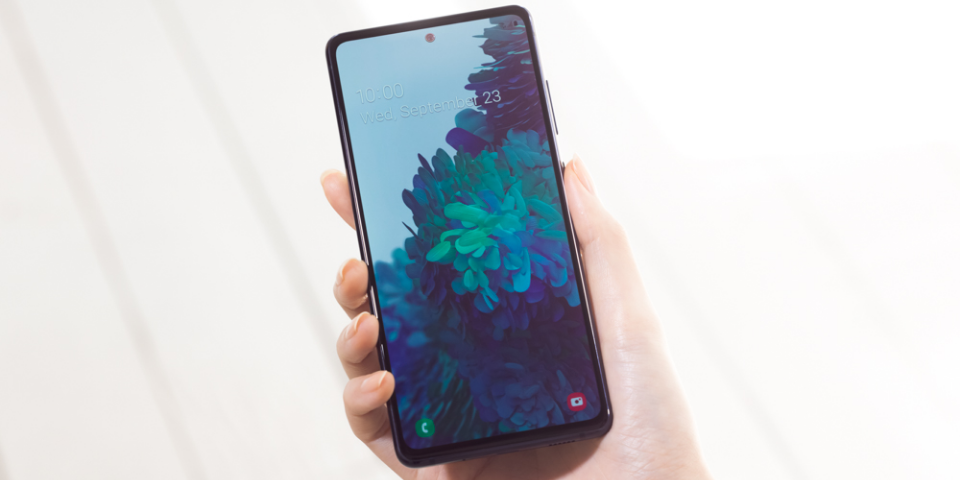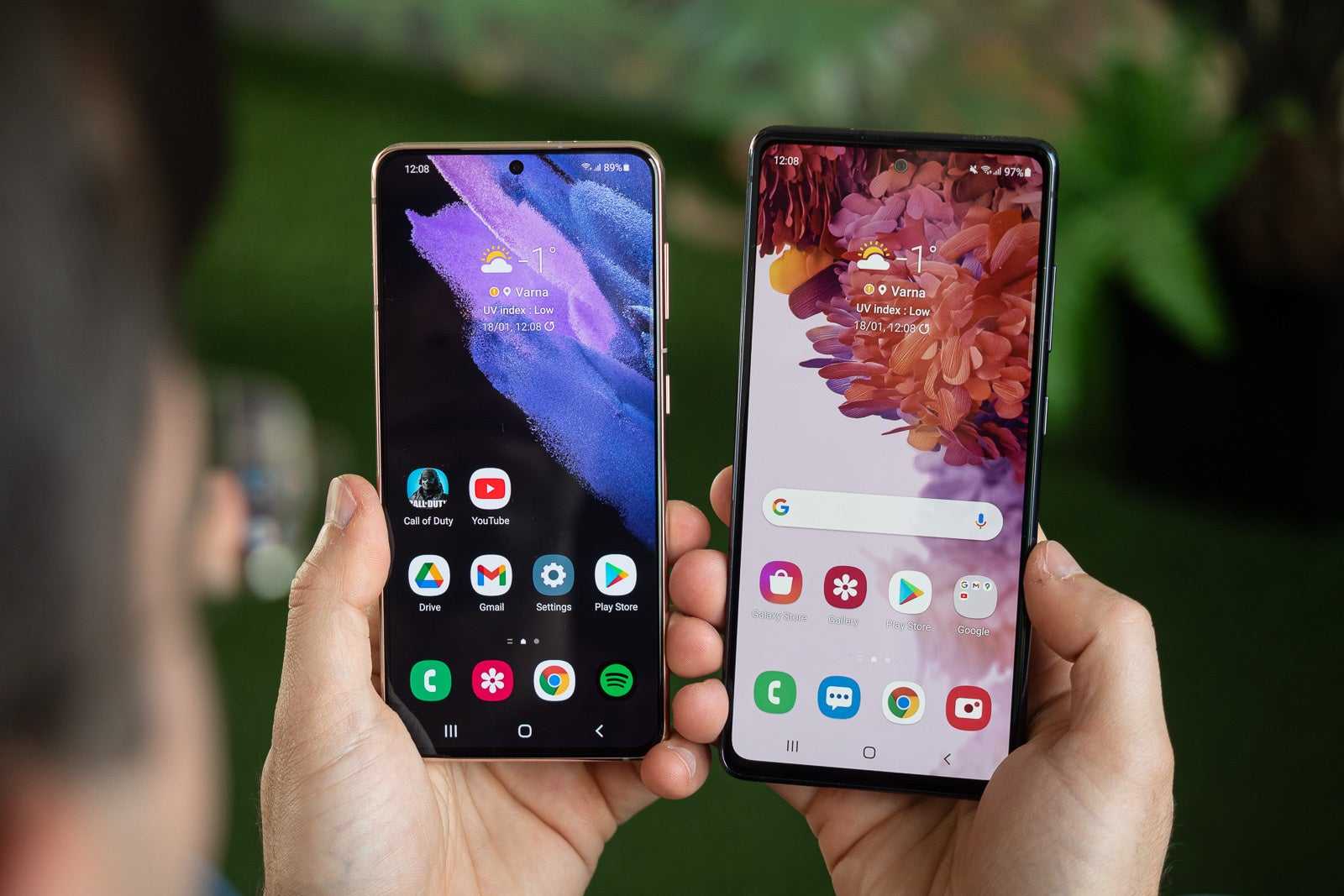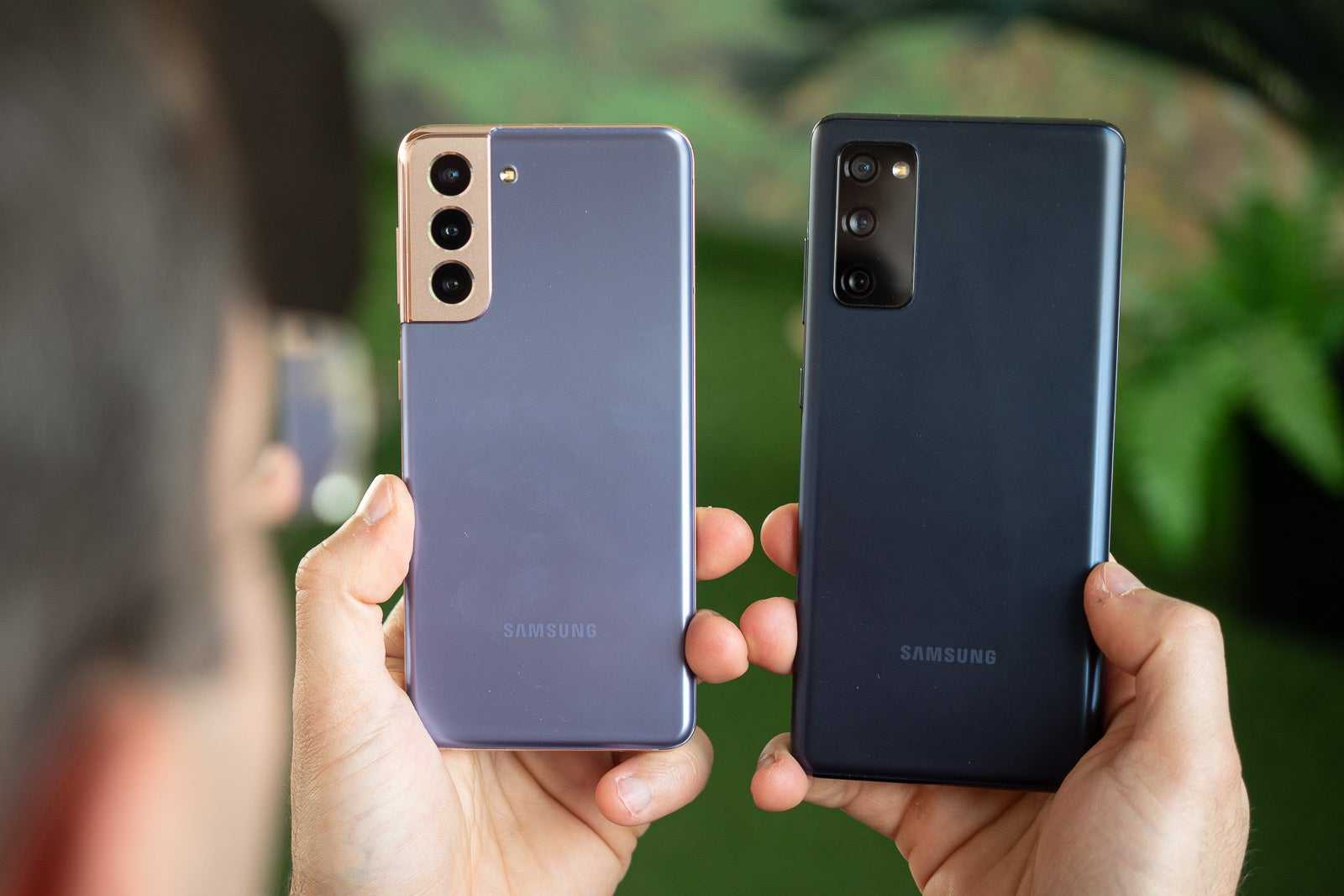Samsung Galaxy S21 vs. Galaxy S20 FE: Specs
Swipe to scroll horizontally
| Row 0 — Cell 0 | Samsung Galaxy S21 | Samsung Galaxy S20 FE |
| Starting price | $799 | $699 |
| Screen size | 6.2 inch AMOLED (2400 x1080) | 6.5 inch AMOLED (2400 x 1080) |
| Refresh rate | 48 — 120Hz | 120Hz |
| CPU | Snapdragon 888 | Snapdragon 865 |
| RAM | 8GB | 6GB |
| Storage | 128GB, 256GB | 128GB |
| microSD? | No | Yes |
| Rear cameras | 12MP wide (ƒ/1.8), 12MP ultra-wide (ƒ/2.2), 64MP telephoto (ƒ/2.0) with 3x hybrid zoom/30x digital | 12MP main (ƒ/1.8), 12MP ultrawide (ƒ/2.2), 8MP telephoto (ƒ/2.4) 3x hybrid zoom/30x digital |
| Front cameras | 10MP (ƒ/2.2) | 32MP (ƒ/2.2) |
| Battery size | 4,000 mAh | 4,500 mAh |
| Size | 6 x 2.8 x 0.31 inches | 6.29 x 2.93 x 0.33 inches |
| Weight | 6.07 ounces | 6.7 ounces |
| Colors | Phantom Violet, Phantom Pink, Phantom White, Phantom Gray | Navy, Lavender, Mint, Red, White, Orange |
Display
The Samsung Galaxy S21 has a slightly sharper screen than the Galaxy S20 FE.

The Samsung Galaxy S20 FE (in photo) supports a refresh rate of 120Hz.
The two have the same 2400 x 1080 resolution, but the Samsung Galaxy S20 FE has a bigger 6.5-inch AMOLED Infinity-O display than the Galaxy S21’s 6.2 incher. In other words, the former offers more screen real estate, but the latter has a slightly sharper picture quality, clocking in at 421 ppi as opposed to 407 ppi.
They also have flagship features like a 120Hz refresh rate and HDR10+ support. However, the Galaxy S21 has the upper hand here, thanks to its adaptive refresh rate option. For the uninitiated, that means it can drop down to 48Hz whenever 120Hz isn’t needed to save battery life.
Last but not least, both have under-display fingerprint readers. However, the Galaxy S21 uses an ultrasonic scanner instead of the Galaxy S20 FE’s optical counterpart, which unlocks slower and is less accurate.
Display
screen size
6.5″
6.4″
The size of the screen (measured diagonally).
Display type
OLED/AMOLED
OLED/AMOLED
The type of technology used in the display.
pixel density
405 ppi
411 ppi
Pixel density is a measurement of a screen’s resolution, expressed as the number of pixels per inch (PPI) on the screen. A higher pixel density translates into more clarity and sharpness for the images rendered on the screen, thus improving the quality of the viewing experience.
resolution
1080 x 2400 px
1080 x 2400 px
Resolution is an essential indicator of a screen’s image quality, representing the maximum amount of pixels that can be shown on the screen. The resolution is given as a compound value, comprised of horizontal and vertical pixels.
refresh rate
120Hz
120Hz
The frequency at which the display is refreshed (1 Hz = once per second). A higher refresh rate results in smoother UI animations and video playback.
touch sampling rate
240Hz
240Hz
The touch sampling rate is the speed at which a screen can register your touch input and respond by rendering the next frame. Also called the touch refresh rate.
brightness (typical)
800 nits
Unknown. Help us by suggesting a value. (Samsung Galaxy S21 FE 5G)
A nit is a measurement of the light that a display emits, equal to one candela per square meter. Brighter displays ensure a screen’s contents are easy to read, even in sunny conditions.
has branded damage-resistant glass
Samsung Galaxy S20 FE
Samsung Galaxy S21 FE 5G
Damage-resistant glass (such as Corning Gorilla Glass or Asahi Dragontrail Glass) is thin, lightweight, and can withstand high levels of force.
Gorilla Glass version
Gorilla Glass 3
Gorilla Glass Victus
Gorilla Glass is one of the most popular brands of chemically strengthened glass, manufactured by Corning. Several versions have been developed, the newer ones being more durable and providing better damage resistance.
Samsung Galaxy S21 против Samsung Galaxy S20 FE: дизайн и экран
Самсунг Галакси С21.
(Изображение предоставлено Samsung)
Когда вы впервые смотрите на Galaxy S21 в сравнении с S20 FE, на самом деле их не так просто отличить друг от друга, такова приверженность Samsung эстетике своего бренда. Если присмотреться, есть несколько ключевых отличий.
Начнем с того, что Galaxy S20 FE — это более крупный телефон, его диагональ составляет 6,5 дюйма, а у Galaxy S21 — 6,2 дюйма. Как и следовало ожидать, это также делает S20 FE более тяжелым телефоном из двух. Основное различие в дизайне заключается в их задних камерах, причем камера S21 очерчивается к краю телефона, а не имеет более зазубренный вид S20 FE.
Оба телефона имеют пластиковые задние панели, а не стекло премиум-класса, которое вы найдете в более дорогих моделях, которые вы найдете в диапазонах Galaxy S20 / S21, в то время как они также обменивают изогнутый экран на плоский. Этот выбор удешевляет телефоны, и, хотя вам могут не хватать этих ультра-премиальных функций, они не снижают производительность этих телефонов Samsung.
Когда дело доходит до их дисплеев, между ними действительно не так много различий. Оба имеют качественные AMOLED-экраны с разрешением 2400×1080 и работают на частоте до 120 Гц. Galaxy S21 будет естественным образом переключаться между 48 Гц и 120 Гц по мере необходимости (что помогает экономить энергию), а экран Galaxy S20 FE, конечно, больше.
Samsung Galaxy S21 vs Samsung Galaxy S20 FE: Specs & Performance
The Samsung Galaxy S21.
(Image credit: Samsung)
On to the hardware, so far there’s not a huge gulf between these Samsungs, but being the newer phone, the S21 does take the edge here.
Mainly it’s down to the processor. The Galaxy S21 is home to the Qualcomm Snapdragon 888, which is a newer and faster chip than the Snapdragon 865 powering the Galaxy S20 FE. While the S21 also steps in front with 8GB of RAM compared to the 6GB of the S20 FE.
Both phones come with 128GB of storage as standard, though you can upgrade the Samsung Galaxy S21 to 256GB. Both phones are also 5G capable.
All of this means that the Galaxy S21 is the faster phone. Both these smartphones can handle pretty much anything you throw at them, but if you want the speediest handset, that’s the newer model.
Samsung Galaxy S21 vs Samsung Galaxy S20 FE price and availability
The Samsung Galaxy S20 FE hit the shops on October 2 2020, while the Samsung Galaxy S21 came later on January 29 2021.
Prices for the Samsung Galaxy S20 FE start from $699/£699/AU$1,149 for a 5G model. Alternatively, there are 4G models available in the UK and Australia for £599 and AU$999 respectively, but we wouldn’t recommend those for anyone looking to future proof their purchase.
The Samsung Galaxy S21 is slightly more expensive at $799/£769/AU$1,249 for a device with 128GB of storage or a 256GB variant for $849/$819/AU$1,349.
That means the Samsung Galaxy S20 FE is the more affordable option of the two, but there’s not a huge amount between them when you consider you’re likely to be investing in one of these phones for several years.
Samsung Galaxy S20 FE
The S20 FE is a terrific phone at a great price, with many features as the newer S21. It’s the most affordable option in the Galaxy S series, with a larger screen and plenty of great colors to choose from.
Samsung Galaxy S20 FE
Even better value
Expandable microSD storage
Optical 3x telephoto camera
Retails for $100 less
Larger battery
Older specs and software
Less generous trade-in
When the launched last fall, it set a new standard for Samsung’s affordable flagship line, offering just about everything the higher-end models could do for hundreds less. The follows in the FE’s footsteps with a flat display, plastic body, and all of the same ultra-powerful specs of its pricier counterparts. So which of these affordable models is the right choice for you?
Display
Image 1 of 2
The Samsung Galaxy S21(Image credit: TechRadar)
The Samsung Galaxy S20 FE(Image credit: Future)
Both phones use the same resolution — 2400 x 1080 — and the same 120Hz refresh rates. Where things differ most noticeably is when it comes to screen size. As you’d expect, the Samsung Galaxy S20 FE is bigger with a 6.5-inch display compared to the Samsung Galaxy S21’s 6.2-inch display.
They also both offer AMOLED display types with the Galaxy S21 providing a ‘dynamic’ panel. What does that mean? It has an adaptive refresh rate that switches between 48 to 120Hz as and when needed.
Neither can compete with the Samsung Galaxy S21 Ultra’s superior QHD screen, but you’ll be hard-pressed to notice the difference if you placed a Samsung Galaxy S21 and Samsung Galaxy S20 FE next to each other.
Bear in mind that the Samsung Galaxy S21 will be more comfortable to hold in one hand, but widescreen media content will look better on the Samsung Galaxy S20 FE’s larger display.
Galaxy S21 vs Galaxy S20 FE camera comparison

Cameras are key for every flagship phone. So, what is Samsung offering users with its cheapest Galaxy S21 model compared to the budget Galaxy S20 FE? Here’s the hardware side of it:
Main and ultra wide sensors are pretty much identical (there are some slight differences) and for telephoto, the S20 FE is using a camera with actual optical zoom unlike the Galaxy S21, which uses a large sensor and crops for zoom. Here are a couple of examples:


Galaxy S20 FE 10X Zoom >
It’s pretty clear which picture is the better one. The optical zoom on the S20 FE helps quite a lot even at 10x zoom and its photo looks decent. Meanwhile, the one from the Galaxy S21 is pixelated and lacks detail.


Galaxy S20 FE 10X Zoom >
At 30X, we can’t really expect good quality, but the Galaxy S20 FE sample once again has more detail, albeit being noisier, while the one from the Galaxy S21 is a smudge-fest.
If we compare regular shots from the two phones, the differences pretty much disappear:


Galaxy S20 FE >
The HDR on the Galaxy S21 is slightly better, but that’s about it. Here are some more camera samples from the two phones:
It’s worth noting that the Galaxy S21’s chip allows for some new camera software features which the Galaxy S20 FE lacks, like Single Take and Director’s View. But those will likely be seldom used in real life regardless of how cool they look in marketing materials, so we can’t say you’re missing out much. The conclusion at the moment is that the Galaxy S21 doesn’t offer anything next-gen compared to the S20 FE.
Galaxy S21 vs Galaxy S20 FE design comparison
The Galaxy S21 and S20 FE being released just a few months apart means we shouldn’t expect a huge difference in how they look. As you can see below, the main difference between the two phones, at first glance, is the size. That’s to be expected since the S21 is the smallest phone of the S21 trio, but we’ve picked the S21 rather than the S21+ because the price will likely be a bigger factor for people than a fraction of an inch in size difference.
Samsung Galaxy S21
Dimensions
5.97 x 2.8 x 0.31 inches
151.7 x 71.2 x 7.9 mm
Weight
6.03 oz (171 g)
Samsung Galaxy S20 FE
Dimensions
6.29 x 2.93 x 0.33 inches
159.8 x 74.5 x 8.4 mm
Weight
6.70 oz (190 g)
Samsung Galaxy S21
Dimensions
5.97 x 2.8 x 0.31 inches
151.7 x 71.2 x 7.9 mm
Weight
6.03 oz (171 g)
Samsung Galaxy S20 FE
Dimensions
6.29 x 2.93 x 0.33 inches
159.8 x 74.5 x 8.4 mm
Weight
6.70 oz (190 g)
See the full Samsung Galaxy S21 vs Samsung Galaxy S20 FE size comparison or compare them to other phones using our Size Comparison tool.
The Galaxy S21 also has a slightly slimmer bottom bezel than that of the S20 FE, but that’s just nitpicking. Here are some more display specs:

The displays are actually more similar than some of you might have expected. The lower resolution and the flat panel on the premium Galaxy S21 are the biggest changes this year. Of course, the panel on the S21 will be one of Samsung’s best so far and a tier higher than that on the S20 FE. The «dynamic» part refers to the Galaxy S21’s adaptive refresh rate. The phone will automatically adjust its refresh rate within the range of 48 to 120Hz.
You’ll have to put the two phones side-by-side to tell exactly what the differences are in a real-life scenario. Once we have our S21 unit, we’ll make sure to do just that and report the results.
It’s worth noting that the glass on the Galaxy S21 is Gorilla Glass Victus, Corning’s best right now, which should make the S21 more durable than the S20 FE.
The same can’t be said for the back of the S21, however, as Samsung has downgraded the back panel of the Galaxy S21 to a plastic one, rather than the glass that was covering the S20’s back panel. The Galaxy S20 FE, being a budget flagship, also has a plastic back.

The biggest difference on the back sides of the phones is the camera module. The signature design element on the Galaxy S21 series is the camera bump’s edge overflowing on the side of the phone, while on the S20 FE the camera bump is a typical rectangular island.
And yes, you do get different colors with each phone.
Design
Antonio Villas-Boas
The Galaxy S21 phones are undoubtedly more luxurious and sleek with their ultra-narrow bezels around the screen and flashy wrap-around camera module. The Galaxy S20 FE also has a plastic back with a matte finish, while the Galaxy S21 phones employ a frosted matte glass. That said, while the Galaxy S20 FE’s plastic back looks bad on paper, it’s almost imperceptible from glass — I actually forgot that its back is plastic until I re-read my own review.
Thankfully, the Galaxy S20 FE, S21, and S21 Plus all have flat screens rather than the curved edges you’d find on the Galaxy S21 Ultra and some previous Galaxy S models.
Speaking of the screen, there’s no noticeable difference between the screen on the Galaxy S20 FE and the Galaxy S21 phones. Both have the same resolution, refresh rate, and similar AMOLED technology that makes colors pop, and delivers perfect black color and high brightness that makes for unmatched contrast.
Advertisement
Samsung Galaxy S21 vs. Galaxy S20 FE: Display
You’ll get a larger display with the Galaxy S20 FE, as it offers a 6.5-inch AMOLED panel to the 6.2-inch screen on the Galaxy S21. Both phones offer FHD+ resolution at 2400 x 1080. That means things are a little sharper on the S21’s smaller screen, as it offers 421 pixels per inch to the Galaxy S20 FE’s 407.
Galaxy S20 FE (Image credit: Future)
Each phone can support 120Hz refresh rates — significant given each phone’s respective price tag, since that’s a feature normally reserved for the most expensive phones. Only the Galaxy S21 offers a dynamic refresh rate, though, ranging from 48Hz to 120Hz depending on what you’re doing with your phone. (The more screen movement, the faster the refresh rate.) The Galaxy S20 FE is stuck at 120Hz if you enable the feature, which could put a hit on battery life.
(Image credit: Future)
The Galaxy S21’s display is brighter, though just by a little bit. We measured a maximum brightness of 711 nits on the S21, which is slightly better than the Galaxy S20 FE’s 679 nit reading. The S20 FE screen captures more of the DCI-P3 color space (133.3% vs.77.4%), while the colors on the S21 were slightly more accurate than the Galaxy S20 FE.
Samsung Galaxy S21 vs. Galaxy S20 FE: Software and special features
The Galaxy S21 ships with Android 11 pre-installed, which means it also features Samsung’s One UI 3 interface built on top of the latest version of Android. While the Galaxy S20 FE came out around the same time as Android 11’s release, it still shipped with Android 10, but the Android 11 update has been rolling out to devices.
That means there aren’t many software differences between these two phones, as Samsung reserved many of the special features for the Galaxy S21 Ultra. If you want S Pen support, for example, you’ll have to pay up for the $1,199 Ultra, as that feature is not included with the Galaxy S21.
Battery life
In both the Samsung Galaxy S20 FE and Samsung Galaxy S21’s cases, expect to keep an eye on their power levels throughout the day. Both will make it to the end of the day but you might need to make some concessions with settings and features if you use them a lot.
Specs-wise, the Samsung Galaxy S20 FE has a 4,500mAh battery while the Samsung Galaxy S21 offers a 4,000mAh battery life. Both will just about make it to the end of the day but features like 5G and the 120Hz display take their toll. There are at least several different power-saving modes to make it a bit easier to achieve.
Battery life will undoubtedly be impacted if you take advantage of both phones’ reverse wireless charging. However, it’s a useful feature if you want to top up your earphones or smartwatch during the day.
Both devices are compatible with Qi wireless charging and offer fast-charging via 25W USB-C chargers but note that the Samsung Galaxy S21 doesn’t come with a charger. That’s supposedly due to Samsung’s urge to cut down on e-waste with the thinking being that you probably already have a compatible USB-C charger available to use anyhow.




























